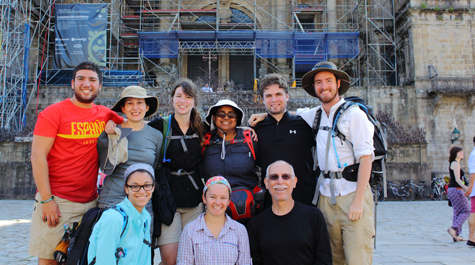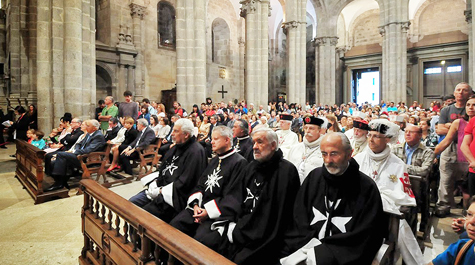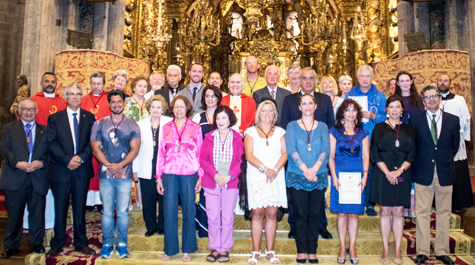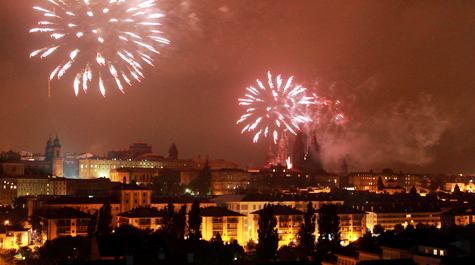A uniquely rewarding pilgrimage
Ryan Goodman would stare at the long line of pilgrims waiting outside the cathedral in Santiago de Compostela, Spain -- some ebullient, some sobbing, some with feet blistered or ankles sprained, some impatient, some lost in the remembrance of a departed loved one.
He knew what they were experiencing. He’d experienced it himself, and it made him anxious to offer them comfort.
Earlier this summer, Goodman ’14 and a group of faculty and fellow William & Mary students traveled the “English Way” of the Camino de Santiago, a centuries-old pilgrimage in Europe. For them it was a six-day, 75-mile journey from Ferrol on the northern coast of Spain to Santiago de Compostela and the Roman mausoleum that is said to house the remains of James the Apostle.
This is where pilgrims step down into the cathedral’s crypt to venerate the saint, one of Jesus’ original 12 apostles. It is also barely a block from the Pilgrim’s Office, where pilgrims line up to receive the Compostela – or certificate -- that acknowledges their accomplishment and their arrival in the city. It’s the moment when the Camino officially comes to a close.
Goodman said he embarked on the pilgrimage because he “needed a moment after graduating from William & Mary to step back and give myself personal, spiritual and professional perspective … The Camino gave me the tools to understand myself better -- and that is why it was so important to give back.”
Goodman, a double major in chemistry and Hispanic studies who is fluent in Spanish and English, developed a personal research project in Santiago and later spent two weeks as a volunteer, helping manage the line and selling carton tubes to protect the treasured Compostela for each pilgrim’s journey home.
But once the dean of the cathedral and coordinators of the Pilgrim’s Office saw how naturally he interacted with everyone, his summer plans changed. Because he was not in possession of a Spanish work visa, he was offered an “internship.” He received housing in a monastery, and a stipend to cover basic living expenses and the change of his flight back to the United States.
“Study-abroad directors joke that the Reves Center inconveniently requires them to return with all the students they take to foreign locations,” said George Greenia, professor of Hispanic studies, who along with Kathleen Jenkins, associate professor and chair of the sociology department, accompanied the students. “But this year, Kathleen and I left one student behind on purpose.
“It’s common enough for our students to volunteer with skill and generosity while abroad. But it’s remarkable to be invited to stay on in a paid position. It was a combination of advanced language skills, compassion and personal warmth that made all the difference in Ryan’s case.”
After his W&M travel and study companions left, Goodman turned his focus toward writing Compostelas “and being the best representative of the cathedral possible for newly arrived pilgrims.” That morphed into making sure that what pilgrims purported to be stamps collected along the way to Santiago were, in fact, legitimate so that “the value of the Compostela could be maintained.”
“The particular moment of giving or declining a Compostela is very intense and emotionally ridden,” he said. “Many of these pilgrims have walked more than 800 kilometers through northern Spain … When they arrive at the Pilgrim's Office, they're at their most vulnerable.” 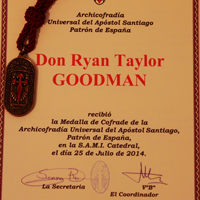
Goodman said that what shocked him most about his experience was the extraordinary hospitality of his office co-workers.
“When the William & Mary group left, I was jokingly ‘adopted’ into the family, something that I laughed off until I realized how much my work and dedication meant to them, and their love and care to me -- all this after knowing them for a mere two weeks," he said. "They would introduce me to their families, and sometimes I would spend the weekend with them at their families’ homes on the coast. I never felt bored or alone.”
In addition to an invitation to return to work at the Cathedral next summer, Goodman came back to the U.S. with membership in the Archconfraternity of St. James.
The Archconfraternity is an organization established by the cathedral for all who work in supporting the Camino throughout the world. To join, one must apply and be sponsored by two current members of the Archconfraternity. Goodman’s sponsors were the dean of the Cathedral, the Rev. Segundo Pérez, and the director of the Pilgrim's Office, Maria Neira Calvo.
The medal is awarded only three times a year, including on the feast of St. James, the single most important day for the city of Santiago de Compostela and the cathedral.
Having been security cleared, Goodman was there, celebrating mass on the feast of St. James. Four rows away, so were the king and queen, Felipe VI and Letizia. Surrounding Goodman were dignitaries from all levels of national, local and regional government -- including the president of Spain, Mariano Rajoy Brey. During the induction ceremony and after the royalty had departed, Goodman sat on the king's throne.
Still, in the long run, it may have been the pilgrimage that had the greatest impact.
“In the course of walking 118 kilometers, I processed many things regarding my future,” he said. “I left with much greater confidence in myself and enthusiasm for the next exciting chapter of my life.”
 Skip to main content
Skip to main content

